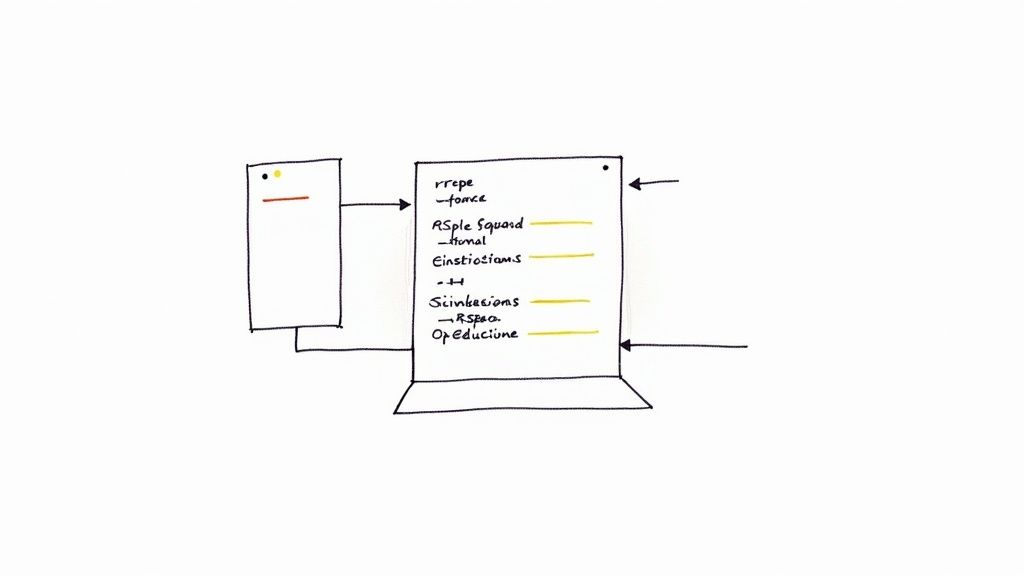Master Your Code with RSpec Test Strategies

Setting Up Your RSpec Test Foundation

Creating a robust testing setup with RSpec is key for any successful project. Think of your RSpec tests as the foundation of a building. A solid foundation ensures stability and long-term success. This involves understanding the core parts of RSpec and how they work together.
Structuring Your Test Suite
A well-structured test suite is like a well-organized blueprint. It makes it easier to navigate, understand, and maintain your tests. Grouping similar tests together in logical files and directories is a best practice.
- Group similar tests: Organize tests by category, such as model, controller, or feature.
- Use descriptive filenames: Clearly indicate the contents of each file. For instance, tests for the
Usermodel should be in a file nameduser_spec.rb. - Maintain a consistent directory structure: Adhere to standard RSpec conventions, such as placing model tests in
spec/modelsand controller tests inspec/controllers.
This organization simplifies finding and updating tests as your project expands.
Understanding RSpec Syntax
RSpec uses a domain-specific language (DSL) to make tests more readable and expressive. This DSL provides specific keywords for defining and structuring your tests. The core components are describe, it, and expect.
describe: Defines the subject under test, like a class or method.it: Contains an individual test case, describing a specific behavior you expect.expect: Sets the expectation for the test, asserting what the outcome of the code should be.
Here's a simple example:
describe User do it 'has a name' do user = User.new(name: 'John Doe') expect(user.name).to eq('John Doe') end end
This code tests the User model, specifically checking if the name attribute is correctly assigned.
Balancing DRY and DAMP Principles
RSpec testing often involves balancing DRY (Don't Repeat Yourself) and DAMP (Descriptive and Meaningful Phrases) principles. DRY encourages minimizing code duplication, often achieved using before and let blocks for setup logic. DAMP, on the other hand, prioritizes test readability, even if it means some repetition.
The RSpec style guide suggests starting with DAMP, writing tests with some duplication within it blocks. Then, refactor towards DRY principles once the tests are functioning correctly. This approach ensures tests are both maintainable and easily understood. Using let statements, which lazily evaluate values, is often preferred over before blocks for optimizing test performance. Learn more about RSpec best practices: Understanding RSpec Best Practices.
For further reading on testing and CI/CD, check out: Mergify Blog Sitemap.
By grasping these foundational concepts, you'll create a robust RSpec testing framework that grows with your project. This proactive approach to testing improves code quality and simplifies debugging in the long run. A solid foundation in RSpec means you're well-equipped to write effective rspec test cases and deliver high-quality code.
Crafting RSpec Test Cases That Actually Matter

Mastering the syntax of rspec test is just the first step. The real power comes from designing tests that truly validate your code's behavior and act as living documentation. This means understanding how to target those tricky edge cases and ensuring your tests remain robust as your application evolves.
Designing Effective Test Cases
Effective rspec test cases go beyond simply checking for expected return values. They dig into the subtleties of your application's logic, ensuring it holds up in various scenarios.
- Focus on Behavior: Concentrate your tests on what your code does, not how it does it. Test the public interface and the observable outcomes. Don't get bogged down in internal implementation details.
- Identify Edge Cases: Push your code to its limits. Think about unusual inputs, boundary conditions, and potential errors. What if a user inputs an empty string? What happens with a very large number? These are the scenarios that can uncover hidden bugs.
- Prioritize Critical Paths: Focus your testing efforts on the core features users depend on. A failure in these areas has a much larger impact than a minor UI issue.
This targeted approach allows you to identify potential problems early and maintain confidence in your code’s stability.
Testing Different Layers of Your Application
A comprehensive testing strategy covers different layers of your application. This ensures each component works correctly both in isolation and as part of the larger system.
- Unit Tests: These
rspec testcases isolate individual units of code, like methods or classes, to verify their behavior independently. - Integration Tests: These tests focus on how different units of code interact. They often involve testing the connections between models, controllers, or external services.
- System Tests (or End-to-End Tests): Simulating real user interactions, these tests validate the behavior of the entire system, ensuring everything works together seamlessly.
By testing at these different levels, you build a safety net that catches problems early and reduces the risk of regressions.
Maintaining Testability and Avoiding Brittle Tests
As your codebase expands, maintaining testability and preventing brittle tests – tests that break with minor code changes – becomes critical. This keeps your testing process efficient and avoids a maintenance nightmare. A common pitfall in RSpec is writing tautological or pointless tests that mirror the code's implementation instead of testing its behavior. For example, testing if a model has_many :students isn't as valuable as testing what that association enables, like calculating a classroom's average GPA.
Focusing on behaviors, not just implementation details, leads to more meaningful rspec test cases and higher code quality. Learn more about avoiding pointless tests: Discover more insights about pointless RSpec tests.
Effective vs. Ineffective RSpec Tests
The following table illustrates the difference between valuable test approaches and common anti-patterns. It highlights how focusing on behavior-driven tests leads to more robust and maintainable code.
| Test Type | Ineffective Approach | Effective Approach | Impact on Code Quality |
|---|---|---|---|
| Model Test | Verifying existence of associations (e.g., has_many :users) |
Testing behaviors enabled by the association (e.g., counting associated users) | Improves focus on functionality |
| Controller Test | Directly testing private methods | Testing controller actions and their responses | Encourages a cleaner public interface |
| System Test | Testing every possible UI interaction | Focusing on critical user workflows | Promotes more efficient testing |
By prioritizing meaningful tests and avoiding redundant checks, you can build a resilient test suite that adapts to your evolving application, provides valuable insights, and prevents regressions.
Supercharging Your RSpec Test Performance

Slow rspec test suites can significantly impact developer productivity. This section explores practical strategies for optimizing your RSpec test performance, helping you create a faster and more efficient testing process. The key is identifying bottlenecks and understanding how to address them for a healthy and performant test suite. Addressing these challenges ensures rapid feedback without compromising thoroughness.
Identifying Performance Bottlenecks
Before optimizing, it's crucial to understand where the slowdowns occur. Several factors can contribute to slow test execution times.
- Database Interactions: Excessive database queries in tests can be a major performance drain.
- Factory Cascades: Creating many interconnected objects via factories in each test can lead to unnecessary object creation and database operations.
- External Dependencies: Calling external APIs or services during tests can introduce latency.
- Complex Setup and Teardown: Overly complicated test setup and teardown processes add overhead.
Identifying these bottlenecks focuses your optimization efforts where they'll have the greatest impact. This targeted approach maximizes results while minimizing wasted effort.
Optimizing Your RSpec Test Configuration
Several configuration adjustments can improve overall test performance. Small tweaks can lead to noticeable improvements across the entire suite. These optimizations reduce overhead and focus resources where needed.
- Parallel Testing: Running tests across multiple threads or processes drastically reduces execution time, especially with multiple CPU cores. This leverages available processing power.
- Database Optimization: Strategies like using transactional fixtures or a dedicated test database can minimize overhead from database operations. This streamlines database interactions, reducing wait times.
- Mocking and Stubbing: Mocking external services or complex dependencies prevents slow network requests and simplifies test setup. This allows tests to run faster and more reliably.
Proper configuration sets the stage for efficient rspec test execution. Consider using parallel_tests for parallel testing. This can significantly decrease execution time by using multi-core processors. Learn more about speeding up RSpec tests. Now, let's explore techniques for faster tests, a crucial aspect of developer productivity.
Implementing Practical Optimization Techniques
After identifying bottlenecks and configuring your environment, several practical techniques can further improve performance. These strategies can be implemented without major refactoring or disruption. This allows you to quickly gain performance improvements while maintaining your test suite’s integrity.
- Caching Data: Caching frequently used data, like factory-generated objects, eliminates redundant calculations or database queries. This ensures data is readily available.
- Profiling Tests: Profiling tools pinpoint specific areas of slowness within individual tests. RSpec's
--profileoption highlights long-running examples. This targeted insight allows you to optimize the most time-consuming tests. - Optimizing Test Design: Writing focused tests that target specific behaviors, rather than testing everything at once, can reduce execution time. This ensures efficient use of resources.
You might be interested in: Mergify Sitemap. Combining these techniques creates a high-performing rspec test suite with rapid feedback without compromising coverage. These improvements result in shorter feedback loops, increased developer productivity, and faster development cycles, ultimately leading to higher quality code and a more efficient development process.
Advanced RSpec Test Techniques That Deliver Results

Building on the fundamentals of rspec test, let's explore advanced strategies to elevate your testing game. These techniques, commonly used by seasoned Ruby developers, tackle real-world testing obstacles and result in more maintainable and efficient test suites.
Custom Matchers for Enhanced Readability
Custom matchers bring clarity and expressiveness to your rspec test specifications. They package complex logic into reusable units, simplifying assertions and boosting readability. Imagine repeatedly verifying a user's role. A custom matcher like have_role(:admin) is much clearer than a series of expect statements.
- Encapsulate Complex Logic: Custom matchers hide intricate verification logic behind a descriptive interface.
- Improve Readability: Tests become easier to understand and interpret.
- Promote Reusability: Write the logic once and use it everywhere, reducing code duplication and maintaining consistency.
This makes your rspec test code more expressive and reduces the effort needed to understand test assertions.
Testing Complex Dependencies Through Mocking
Mocking and stubbing are crucial for isolating code units and testing them in isolation. These techniques give you control over external dependencies, making tests predictable and less susceptible to outside influences. This allows you to focus your tests on the specific component being examined.
- Isolate Code Units: Mock external services or complex object interactions.
- Control Dependencies: Simulate diverse responses and edge cases from external systems without affecting the actual systems.
- Improve Test Speed: Bypass slow external calls, leading to faster test execution times.
This is particularly valuable when dealing with database interactions, API calls, or other lengthy processes within your rspec test runs. This ensures tests stay fast and focused.
Leveraging Shared Contexts and Metadata
Shared contexts and metadata help organize and manage rspec test suites, especially as projects grow. Shared contexts consolidate common setup logic, and metadata tags tests with attributes useful for filtering or selective test runs.
- Organize Setup Logic: Gather common configurations and dependencies into reusable shared contexts.
- Improve Test Structure: Categorize tests based on characteristics (e.g., integration, unit, slow).
- Control Test Execution: Run targeted subsets of tests using metadata tags.
This modular approach simplifies maintenance and allows for precise test execution based on the test’s purpose.
Creating Flexible Test Suites Through Shared Examples
Shared examples encapsulate repeatable testing patterns, fostering reusability and consistency. If several classes share a similar interface, define the common behavior in shared examples and include it in their respective rspec test cases.
- Promote Code Reuse: Avoid redundant test code.
- Ensure Consistent Behavior: Confirm different components adhere to a shared contract.
- Simplify Test Maintenance: Modify a shared example once to update all related tests.
These advanced techniques are invaluable for building maintainable and effective rspec test suites. They empower you to manage complexity, improve readability, and guarantee code quality. This focus on efficient rspec test practices is vital for any successful project. Proper failure handling is another aspect of strong testing. Learn more about inspecting browser console output for failed tests here. Explore further advanced testing techniques involving factory usage and performance optimization within rspec test here.
Troubleshooting Stubborn RSpec Test Failures
Failures in rspec test suites are an unavoidable part of software development, even with well-crafted code. However, persistent or intermittent failures can be particularly troublesome. This section offers a structured way to diagnose and resolve these tricky issues, transforming testing frustrations into opportunities for code improvement.
Tracing Test Execution and Interpreting Errors
When an rspec test fails, the first step is understanding the underlying cause. RSpec provides detailed error messages, but these can sometimes be difficult to decipher. Effective troubleshooting begins with a careful review of these messages and tracing the test's execution path.
- Analyze Error Messages: Carefully examine the error message, paying close attention to the specific line of code where the failure occurred and the type of error raised.
- Use
putsDebugging: Strategically placedputsstatements in your test code can reveal the values of variables and the flow of execution, helping pinpoint the source of the issue. - Leverage the
binding.pryGem: The binding.pry gem lets you pause test execution at specific points and interactively inspect the state of your application. This type of interactive debugging can offer valuable insights, especially for intermittent or unpredictable issues.
For example, you can insert binding.pry into your rspec test just before the failing line, allowing you to step through the code and examine each variable's value as the test progresses. You can even execute the line manually to see precisely why it fails.
Pinpointing the Root Cause of Intermittent Failures
Intermittent failures, those that occur randomly without a discernible pattern, are particularly challenging. These can often be attributed to issues like:
- Test Order Dependency: Tests should be independent and not affected by the order in which they are executed. If tests modify shared resources or database records, subsequent tests might fail. Ensuring proper cleanup between tests is crucial for maintaining test independence.
- Time-Dependent Tests: Tests that depend on specific times or dates might fail based on the system clock. Consider using time mocking or stubbing techniques to manage time-related dependencies.
- External Dependencies: Relying on external services or APIs can lead to test instability. Mocking these external dependencies helps ensure test predictability and avoids unexpected failures.
Identifying and resolving these issues often requires thorough investigation, frequently involving careful logging, focused debugging, and analysis of test execution patterns.
Identifying Performance Bottlenecks
Performance problems can slow down tests, lengthening development cycles and potentially leading to neglected test suites. Addressing these problems is crucial. As your test suite expands, slow rspec test runs can become a major obstacle. The --profile option is invaluable for identifying slow examples within your suite. For instance, even a minor delay, like a sleep of 0.15 seconds, might be flagged as a potentially slow example. Deeper investigation with profiling tools like stackprof and rblineprof often uncovers more substantial bottlenecks. These tools pinpoint where time is spent within individual tests, revealing patterns like excessive database queries or complex object creation. This data-driven analysis helps developers optimize their tests and enhance overall performance. For more detailed information, check out this article about profiling RSpec tests: A Random Walk Through Profiling RSpec Tests.
To understand how different profiling tools can assist in diagnosing performance issues, refer to the table below:
RSpec Test Profiling Tools Comparison A comparison of different profiling tools and their capabilities for diagnosing RSpec test performance issues
| Profiling Tool | Key Features | Best Use Cases | Setup Complexity | Performance Impact |
|---|---|---|---|---|
rspec --profile |
Built-in, identifies slow tests | Quick overview of slow examples | Minimal setup | Low |
stackprof |
Provides call stack samples | Analyzing method call frequency and duration | Moderate setup | Moderate |
rblineprof |
Line-by-line profiling | Pinpointing performance bottlenecks within specific lines of code | Moderate setup | Higher |
This table highlights the key differences between the basic rspec --profile option and more advanced tools like stackprof and rblineprof, offering insights into their respective strengths and weaknesses. While rspec --profile provides a convenient initial assessment, stackprof and rblineprof allow for more granular analysis of performance issues.
You might also be interested in: Read also: Mergify Sitemap.
Refactoring Problematic Tests
Sometimes, the most effective approach is to refactor or rewrite problematic tests completely. This might involve streamlining test logic, using more suitable RSpec matchers, or decomposing complex tests into smaller, more manageable units. Refactoring tests enhances readability, simplifies complexity, and makes the tests more resilient to future code modifications. This proactive strategy minimizes the need for future debugging and cultivates a healthier, more maintainable test suite. Through these troubleshooting techniques, you can not only fix failing tests but also improve your entire codebase and deepen your understanding of your application.
Integrating RSpec Test Into Your Development Workflow
Integrating rspec test effectively into your development workflow transforms testing from a chore into a powerful asset. It's about building a testing culture where bugs are caught early, accelerating feature delivery and making testing an integral part of the process.
Integrating Tests with CI/CD Pipelines
Continuous Integration and Continuous Delivery (CI/CD) pipelines are vital for modern software development. Integrating your rspec test suite into your CI/CD pipeline ensures every code change is automatically tested before deployment. This offers instant feedback and prevents regressions from hitting production.
- Automated Test Execution: Configure your CI/CD system (like Jenkins or GitHub Actions) to automatically run your
rspec testsuite with each code push. This ensures consistency and quick feedback. - Early Error Detection: Catching errors early through automated testing minimizes the cost and time needed for later fixes.
- Faster Feedback Loops: Automated CI/CD with
rspec testprovides rapid feedback on code changes, enabling faster iteration.
This approach to continuous testing maintains code quality and application stability.
Organizing Tests for Scalability
As your team and codebase expand, organizing your rspec test suite becomes crucial. A well-organized suite simplifies maintenance, improves collaboration, and streamlines test location and updates.
- Modular Test Structure: Group similar tests into logical modules or files. This creates a clear structure and makes finding specific tests easier.
- Descriptive Test Names: Use clear test names that directly explain the behavior being verified, improving readability and understanding.
- Shared Contexts and Examples: Use RSpec's shared contexts and examples to avoid code duplication and maintain consistency, promoting maintainability and reducing redundancy.
Effective rspec test organization creates a scalable testing structure that adapts to your team’s needs.
Generating Meaningful Test Reports
Test reports offer valuable insights into your rspec test suite’s status and effectiveness. These reports allow you to pinpoint areas for improvement, monitor code coverage, and understand code changes' impact on your tests. This information can guide future development and enhance overall testing quality.
- Code Coverage Reports: Track your code coverage to identify areas needing more testing, focusing your efforts where they matter most. Tools like SimpleCov can help visualize this data.
- Test Execution Time Analysis: Monitoring execution time exposes performance bottlenecks. Optimizing slow
rspec testcases improves developer productivity. - Failure Analysis: Examine test failures to understand recurring patterns and address root causes, preventing similar failures.
Integrate these reports into your CI/CD pipeline for regular feedback on test performance and code quality.
Building a Testing Culture
Integrating rspec test effectively isn't just technical; it’s about cultivating a testing culture. Encouraging developers to embrace testing as a core part of their workflow is crucial for long-term success. Establishing clear testing standards and promoting best practices creates a shared understanding of testing’s value.
- Testing Best Practices: Create clear guidelines for writing and organizing tests to ensure readability, maintainability, and a cohesive suite.
- Code Reviews for Tests: Include
rspec testcases in code reviews to validate both application code and tests, promoting knowledge sharing and rigorous review. - Continuous Improvement: Regularly review and refine your testing process using test report data and team feedback, optimizing your workflow over time.
By building a culture that prioritizes rspec test, you improve application quality and stability while empowering developers to write better code. Discover how Mergify can further streamline your development workflow and enhance code quality by optimizing CI/CD processes.





